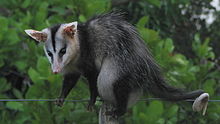| White-eared opossum[1] | |
|---|---|
 | |
| Scientific classification | |
| Kingdom: | Animalia |
| Phylum: | Chordata |
| Class: | Mammalia |
| Infraclass: | Marsupialia |
| Order: | Didelphimorphia |
| Family: | Didelphidae |
| Genus: | Didelphis |
| Species: | D. albiventris |
| Binomial name | |
| Didelphis albiventris Lund, 1840 | |
 | |
| White-eared opossum range | |
The white-eared opossum (Didelphis albiventris) a.k.a timbu, cassaco, is an opossum species found in Argentina, Bolivia, Brazil, Paraguay, and Uruguay.[3] It is a terrestrial and, sometimes, arboreal animal, and a habitat generalist, living in a wide range of different habitats.[3]
For some time, this species was incorrectly known by the name D. azarae, correctly applied to the big-eared opossum. This led to azarae's discontinuation as a species name.[1] From 1993 until 2002, this species also included the Guianan white-eared opossum (D. imperfecta) and the Andean white-eared opossum (D. pernigra) as subspecies.[1]
It is the team mascot of Clube Náutico Capibaribe, a Brazilian football team from Recife, Pernambuco.[4]
Description
The white-eared opossum is about one to three pounds in weight and has black and grey fur, with white hair covering their ears and face, and dark hair on their long tails. They are omnivorous, feeding on invertebrates, small vertebrates, and fruits.[5]
Distribution and habitat
White-eared opossums inhabit open areas, mountains, and deciduous forests and are commonly found in Argentina, Paraguay, Uruguay, Bolivia, Brazil, the Andes, and humid forests of Guyana, Suriname, and southern Venezuela.[6] These areas have disparate environmental characteristics such as rainfall, humidity, water balance and temperature.[7]
The white-eared opossum often changes its habitat depending on its breeding season. Usually populations are higher in the wetter seasons when the young are weaned and begin venturing out for food.[8] Though normally solitary and nomadic, some will group together in burrows, holes, empty garbage or even under houses.
Diet and seed dispersal
South American opossums mainly consume invertebrates such as beetles, diplopods, and opiliones, together with fruit and vertebrates like small birds, mammals, fossorial snakes, and fish.[9] The composition of the diet changes with the seasons and as the animal ages. During the dry season, older opossums prefer to consume vertebrates.[9] On the other hand, the younger opossums consume more invertebrates and fruits during the wet season.[9] These relatively small differences in diet can favour the survival of younger opossums during the wet season because they avoid competition with older animals.[9]
The diet of white-eared opossums also makes them effective seed dispersers.[9] Younger opossums consume smaller fruits than older opossums, so usually the adult opossums disperse larger seeds. However, proportionally, smaller seeds have more chance to pass through the gut without damage.[9]
References
- ^ a b c Gardner, A.L. (2005). "Order Didelphimorphia". In Wilson, D.E.; Reeder, D.M (eds.). Mammal Species of the World: A Taxonomic and Geographic Reference (3rd ed.). Johns Hopkins University Press. p. 5. ISBN 978-0-8018-8221-0. OCLC 62265494.
- ^ Costa, L.; Astua de Moraes, D.; Brito, D.; Soriano, P.; Lew, D. & Delgado, C. (2008). "Didelphis albiventris". IUCN Red List of Threatened Species. 2008. Retrieved 28 December 2008.
- ^ a b Eisenberg, John F.; Redford, Kent H. (2000). Mammals of the Neotropics: Ecuador, Bolivia and Brazil.
- ^ http://www.nautico-pe.com.br/simbolos
- ^ Jorge, S.; Hartleben, C. P.; Seixas, F. K.; Coimbra, M. A.; Stark, C. B.; Larrondo, A. G.; Brod, C. S. (2012). "Leptospira borgpetersenii from free-living white-eared opossum (Didelphis albiventris): First isolation in Brazil". Acta Tropica. 124 (2): 147–151. doi:10.1016/j.actatropica.2012.07.009. PMID 22897870.
- ^ Tocchio, L. J.; Gurgel-Gonçalves, R.; Escobar, L. E.; Peterson, A. T. (2015). "Niche similarities among white-eared opossums (Mammalia, Didelphidae): Is ecological niche modelling relevant to setting species limits?". Zoologica Scripta. 44 (1): 1–10. doi:10.1111/zsc.12082.
- ^ Lemos, B.; Cerqueira, R. (2002). "Morphological differentiation in the white-eared opossum group (Didelphidae: Didelphis)". Journal of Mammalogy. 83 (2): 354–369. doi:10.1644/1545-1542(2002)083<0354:mditwe>2.0.co;2.
- ^ Cáceres, N. C. (2000). "Population ecology and reproduction of the white-eared opossum Didelphis albiventris (Mammalia, Marsupialia) in an urban environment of Brazil". Ciencia e Cultura(Sao Paulo). 52 (3): 171–174.
- ^ a b c d e f Cáceres, N. C. (2002). "Food habits and seed dispersal by the white-eared opossum, Didelphis albiventris, in southern Brazil". Studies on Neotropical Fauna and Environment. 37 (2): 97–104. doi:10.1076/snfe.37.2.97.8582. S2CID 85961182.
